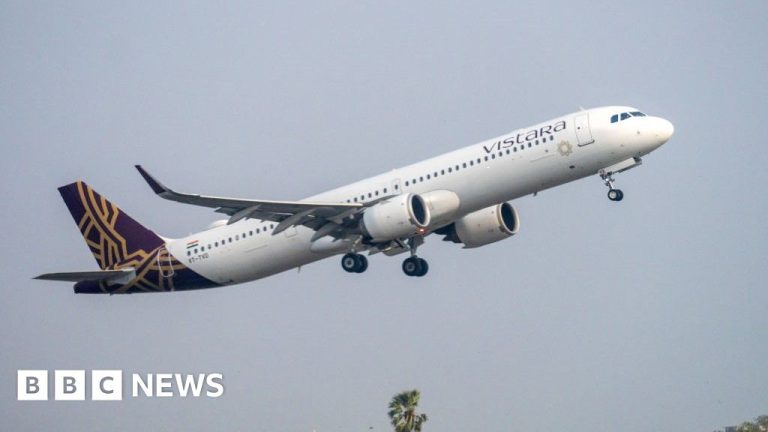Getty Images
Vistara will be fully integrated with Air India from Monday
Indian full-service airline Vistara will operate its last flight on Monday, after nine years of operation.
A joint venture between Singapore Airlines and Tata Sons, Vistara will merge with Tata-owned Air India to form a single entity with an expanded network and larger fleet.
This means that all operations of Vistara will be transferred and managed by Air India, including support kiosks and ticketing offices. The process of migrating passengers with Vistara bookings and existing loyalty programs to Air India has been underway for the past few months.
“As part of the merger process, meals, services and other software elements have been enhanced and incorporate aspects of both Vistara and Air India,” an Air India spokesperson said in an emailed response .
While the merger might impact service standards, the Tatas have assured that Vistara's in-flight experience will remain unchanged.
Known for its high ratings for food, service and cabin quality, Vistara has built a loyal customer base and the decision to retire the Vistara brand was criticized by fans, brand experts and aviation analysts .
The consolidation was effectively carried out to clean up Vistara's books and erase its losses, said Mark Martin, an aviation sector analyst.
Air India was essentially “made to take on a loss-making airline” in a desperate move, he added.
“Mergers are about making airlines more powerful. Never about erasing losses or covering them.”
Certainly, the annual losses of Air India and Vistara have more than halved in the past year, and other operational parameters have also improved. But so far, the merger process has been rocky.
The exercise was fraught with challenges – from pilot shortages that led to mass flight cancellations, to Vistara crews taking mass sick leave due to plans to align their pay structures on those of Air India.
There have also been repeated complaints about poor service standards on Air India, including viral videos showing broken seats and non-working in-flight entertainment systems.
Getty Images
Vistara's demise leaves a void in Indian skies for a full-service premium carrier
The Tatas have announced a $400m (£308m) program to upgrade and modernize the interiors of their older planes, as well as an all-new livery. They also placed orders for hundreds of new Airbus and Boeing planes, worth billions of dollars, to increase their supply.
But this “turnaround” is still incomplete and fraught with pitfalls, according to Mr. Martin. A merger only complicates things.
Experts say the merger also strikes a chord from a brand perspective.
Harish Bijoor, a brand strategist, told the BBC he felt “emotional” that a superior product offering like Vistara, which had developed a “gold standard for Indian aviation ”, ceased its activities.
“It is a big loss for the industry,” Mr. Bijoor said, adding that it would be a monumental task for parent brand Air India to simply “copy, paste and surpass” the high standards set by Vistara, given that it is a much smaller company. airline that is being swallowed up by a much larger airline.
Mr. Bijoor suggests that a better strategy would have been to operate Air India separately for five years, focusing on improving service standards, while maintaining Vistara as a separate brand with the Air India prefix.
“This would have given Air India time and chance to rectify the parent brand and elevate it to the level of Vistara, while retaining its uniqueness,” he adds.
Beyond branding, the merged entity will face numerous operational challenges.
Shutterstock
The new airline's biggest task would be to offer its customers a uniform flight experience.
“Communication will be a major challenge initially, with customers arriving at the airport expecting Vistara flights, only to find the Air India brand,” says Ajay Awtaney, editor-in-chief of Live From A Lounge, an aviation portal . “Air India will need to maintain clear communication for weeks.”
Another major challenge, he notes, is cultural: Vistara's agile employees might struggle to adapt to Air India's bureaucracy and complex systems.
But the merged carrier's biggest task would be to offer its customers a uniform flight experience.
These are “two airlines with very different service formats that are integrated into a single airline. It will be a mix of service formats, cabin formats, branding and customer experience. This will involve learning and unlearning, and such a process has rarely worked with airlines and is rarely effective,” Mr Martin said.
Yet many believe Vistara had to go – now or a few years later.
A historic brand like Air India, with strong global recognition and 'India' imprinted in its identity, would not have allowed a smaller, more premium subsidiary to overshadow its renaissance process.
Financially too, it does not make sense for the Tatas to see two loss-making entities competing with each other.
The combined strength of Vistara and Air India could also put the Tatas in a much better position to compete with market leader Indigo.
The unified Air India Group (which includes Air India Express, which completed its merger with the erstwhile Air Asia India in October) “will be bigger and better with a fleet of nearly 300 aircraft, an expanded network and a workforce stronger work,” Air India said. » said the Indian spokesperson.
“Completing the merger means that Air India will grow overnight and both teams will start cooperating instead of competing with each other. There will never be a good day to merge. Somewhere you had to draw a line,” Mr Awtaney said.
But for many Vistara loyalists, its demise leaves a void in Indian skies for a full-service premium carrier – marking the third such void after the collapse of Kingfisher Airlines and Jet Airways.
It is still too early to tell whether Air India, which often ranks at the bottom of airline rankings, will be able to fill this void.

